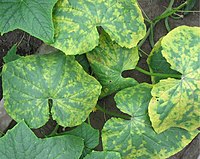
Photo from wikipedia
Sugarcane mosaic disease is a major threat to sugarcane cultivation worldwide. Under Indian conditions, mosaic disease is caused by Sugarcane streak mosaic virus (SCSMV) and Sugarcane mosaic virus (SCMV) either… Click to show full abstract
Sugarcane mosaic disease is a major threat to sugarcane cultivation worldwide. Under Indian conditions, mosaic disease is caused by Sugarcane streak mosaic virus (SCSMV) and Sugarcane mosaic virus (SCMV) either alone or together. A “0–6” scale mosaic severity grading system has been developed after analysing the phenotypic expression of mosaic symptoms in ~ 210 genotypes comprising of cultivated species (Saccharum officinarum, S. sinense and S. barberi), wild species (S. spontaneum and S. robustum) and hybrid-varieties at two diverse environments over a period of three years. They were also screened for the presence of SCSMV and SCMV by RT-PCR assays. Out of the 210 genotypes, only 7 were free of mosaic viruses, indicating the rare possibility of getting resistant genotypes among the world collection of sugarcane germplasm. It also clearly indicates that the mosaic disease is widespread in occurrence and nearly 97% of the varieties/genotypes were infected with mosaic viruses. Overall, the presence of SCSMV, SCMV and both the viruses were recorded in 77 (87.5%), 51 (58%) and 46 (52%) of the 88 species-clones indexed through RT-PCR assays. The hybrid-varieties with mosaic grade of 6 often had mixed infections of both the mosaic viruses, resulting in severe symptom expression and degeneration. The 0–6 scale mosaic phenotyping developed in this study will be useful to screen the world sugarcane germplasm collections against the mosaic disease. The study identified three S. robustum genotypes as resistant to mosaic, indicating the possibility of identifying resistant sources and these may serve as donors for mosaic resistance.
Journal Title: Sugar Tech
Year Published: 2021
Link to full text (if available)
Share on Social Media: Sign Up to like & get
recommendations!